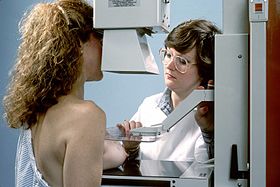User:Mr. Ibrahem/Mammography
| Mr. Ibrahem/Mammography | |
|---|---|
 A women getting a mammogram | |
| Other names | Mastography |
| Complications | Overdiagnosis, anxiety, unnecessary surgery, radiation induced breast cancer[1] |
| Types | Screening, diagnostic[2] |
| Frequency | >39 million/yr (USA)[3] |
Mammography is a low-dose X-ray to examine the breast for breast cancer.[2] It can be carried out in those who have symptoms for diagnosis, or in those without, as screening.[2] The goal is early detection of cancer, with the hope that early treatment will improve outcomes.[2] Concerning findings include lumps and areas of calcium.[2] When concerns occur further medical imaging or biopsy is carried out.[2]
For the average woman, the U.S. Preventive Services Task Force (USPSTF) in 2016 recommended mammography every two years between the ages of 50 and 74.[1] The American College of Radiology recommend yearly screening starting at age 40 while the American Cancer Society recommends started at age 45 and moving to every two years at 55.[4][5][6] The Canadian Task Force recommend mammography every 2 to 3 years between ages 50 and 74 while the European Commission recommends this between ages 50 and 69.[7][8]
Risks include overdiagnosis, anxiety, unnecessary surgery, and a small increase in radiation induced breast cancer.[1] The test may also be falsely negative, resulting in missed cancer.[1] Cochrane in 2013 did not find an effect of screening on either total cancer mortality or breast cancer mortality in well randomized trials.[9] In 2012 they question the need for universal screening.[10] In the United States at least 39 million are done a year.[3] The cost per exam is about 100 USD in the United States.[11]
References[edit]
- ^ a b c d "Recommendation: Breast Cancer: Screening | United States Preventive Services Taskforce". www.uspreventiveservicestaskforce.org. Archived from the original on 7 July 2022. Retrieved 1 August 2022.
- ^ a b c d e f g h "Mammograms | Office on Women's Health". www.womenshealth.gov. Archived from the original on 29 July 2022. Retrieved 1 August 2022.
- ^ a b Health, Center for Devices and Radiological (1 July 2022). "MQSA National Statistics". FDA. Archived from the original on 14 July 2022. Retrieved 1 August 2022.
- ^ Monticciolo, Debra L.; Malak, Sharp F.; Friedewald, Sarah M.; Eby, Peter R.; Newell, Mary S.; Moy, Linda; Destounis, Stamatia; Leung, Jessica W.T.; Hendrick, R. Edward; Smetherman, Dana (September 2021). "Breast Cancer Screening Recommendations Inclusive of All Women at Average Risk: Update from the ACR and Society of Breast Imaging". Journal of the American College of Radiology. 18 (9): 1280–1288. doi:10.1016/j.jacr.2021.04.021.
- ^ "ACS Breast Cancer Screening Guidelines". www.cancer.org. Archived from the original on 9 April 2022. Retrieved 1 August 2022.
- ^ "New American Cancer Society Breast Cancer Screening Guidelines Recommend Mammograms Start at 45". www.breastcancer.org. Archived from the original on 1 April 2022. Retrieved 1 August 2022.
- ^ "Canadian Task Force on Preventive Health Care | Breast Cancer—Patient FAQ". canadiantaskforce.ca. Archived from the original on 25 July 2021. Retrieved 1 August 2022.
- ^ Peintinger, Florentia (2019). "National Breast Screening Programs across Europe". Breast Care. 14 (6): 354–358. doi:10.1159/000503715.
- ^ Gøtzsche PC, Jørgensen KJ (June 2013). "Screening for breast cancer with mammography". The Cochrane Database of Systematic Reviews. 6 (6): CD001877. doi:10.1002/14651858.CD001877.pub5. PMC 6464778. PMID 23737396.
- ^ "Mammography-leaflet; Screening for breast cancer with mammography" (PDF). Archived from the original (PDF) on 2012-09-05. Retrieved 2012-06-24.
- ^ Langreth, Robert. "Too Many Mammograms". Forbes. Archived from the original on 2 August 2022. Retrieved 1 August 2022.
